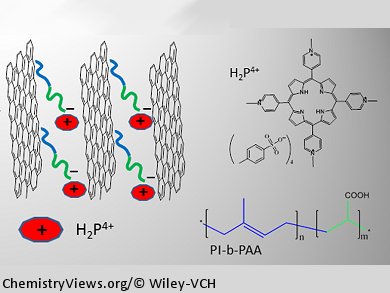The functionalization of graphene can lead to a rich variety of materials for many applications. However, extensive covalent functionalization leads to the introduction of sp3 defects in the graphene layers. To overcome this problem, alternative approaches for functionalizing graphene by non-covalent means is important.
Nikos Tagmatarchis and his colleagues, National Hellenic Research Foundation, Athens, Greece, have managed to integrate a tetracationic porphyrin into exfoliated graphene – formed in aqueous media with the aid of a negatively charged block co-polymer – entirely based on electrostatic interactions.
Titration experiments, followed by absorption and fluorescence spectroscopy, revealed the presence of electronic communication between the porhyrin and graphene in the ground and excited states. With the exfoliated graphene acting as the electron acceptor and the porphyrin acting as a photoexcited electron donor, the charge-transfer interactions of this new hybrid material were investigated. The quenching rate constant of the porphyrin in the graphene/block co-polymer/porpyhrin ensemble was determined to be 4.24 × 108 s–1 and the quantum yield was calculated to be 0.68.
- Photoinduced Charge-Transfer Interactions on a Graphene/Block Copolymer Electrostatically Bound to Tetracationic Porphyrin in Aqueous Media,
T. Skaltas, S. Pispas, N. Tagmatarchis,
Chem. Eur. J. 2013.
DOI: 10.1002/chem.201300806




